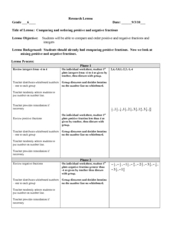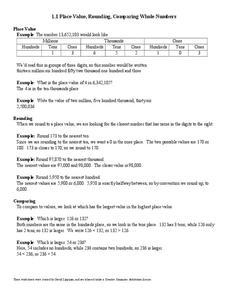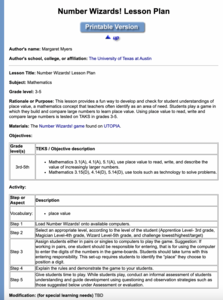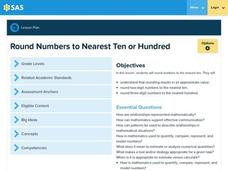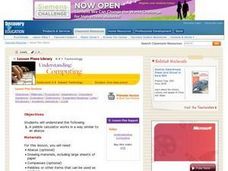Curated OER
Addition and Subtraction Up to Two-Digits
In this finding the sums and differences worksheet, students write the equations in the ones and tens columns and solve and also solve vertical problems with and without regrouping. Students solve 18 problems.
Curated OER
Increasing Order - Integers
For this ordering numbers from least to greatest worksheet, students rearrange negative and positive numbers. Students solve 10 problems.
Curated OER
Comparing and Ordering Positive and Negative Fractions
The comparison and ordering of positive and negative fractions is the focus of this math activity. Sixth graders are given one card each that has a fraction written on it, and they must put themselves into the proper order in a "human...
Curated OER
Same and Different
For this mathematics instructional activity, students first complete the tens place and then add the rest. Then they continue the patterns and compare each column. Students also fill in the missing addends and solve various word problems...
Open Text Book Store
Arithmetic for College Students: Worksheets
Loaded with concepts ranging from multiplying decimals to converting units to solving problems using the order of operations, a thorough practice packet is perfect for a fifth or sixth grade math classroom.
Consumers Energy
The Cost of Electricity
How much is your toaster costing you every day? Young environmentalists calculate the monetary costs of household appliances based on their average consumption of wattage.
Curated OER
Number Wizards! Lesson Plan
Students play a game in which they build and compare large numbers to learn place value. They use place value to read, write and compare large numbers.
Curated OER
Math Prefixes
Young scholars use a dictionary to gather appropriate information for writing simple definitions. They recognize prefixes that relate to numbers, such as mono-, bi-, and tri-. Pupils use their creative abilities to extrapolate new words...
Helping with Math
Identifying and Writing Decimals up to Hundredths
Five sets of blocks representing whole units, tenths, and hundredths are grouped so that learners can evaluate the total values. This provides practice with place value and the use of decimals. Answers are included. The brevity of this...
Pennsylvania Department of Education
Round Numbers to Nearest Ten or Hundred
Third graders review telling time. For this lesson on telling time, 3rd graders discuss various items that show length of time, including clocks, calendars and sand timers. Students review and practice what they already know about...
Curated OER
It's A Snap! (Place Value Made Easy)
Students are introduced to the importance of using place value in number systems. They view a video, play games, explore websites and research the pay scale of three jobs that interest them.
Curriculum Corner
8th Grade Math "I Can" Statement Posters
Clarify the Common Core standards for your eighth grade mathematicians with this series of classroom displays. By rewriting each standard as an achievable "I can" statement, these posters give students clear goals to work toward...
EngageNY
Polynomial, Rational, and Radical Relationships
This assessment pair goes way beyond simple graphing, factoring and solving polynomial equations, really forcing learners to investigate the math ideas behind the calculations. Short and to-the-point questions build on one another,...
Curriculum Corner
Academic Math Vocabulary
The ABCs of math are so important. Find commonly used math terms in a 42-page packet. Each page has the word, a place to write the definition, and a place to give specific examples of the term. A must-have for all math classrooms!
Illustrative Mathematics
Placing a Square Root on the Number Line
There are many ways to approach finding the rational approximation of an unknown square root. Here is a problem that will help math learners make a connection between square roots and their order on a number line. As usual, determine two...
National Research Center for Career and Technical Education
Photoshop Scale
Say cheese! Can your class take a great photo and size it to fit any need? A career and technology-centered lesson plan demonstrates the correct way to resize images in Adobe Photoshop. Scholars view a presentation and work individually...
Curated OER
Prints and Outlines
Learners determine the area of two objects by superimposing one on the other. They compare and order the area of different shapes by covering a larger shape with similar smaller ones. They complete these activities as different stations.
Curated OER
Binary Math
In this physics worksheet, students perform a series of mathematical operations involving binary numbers to answer 11 questions.
Curated OER
Decimal Place Value Chart
In this decimal place value chart instructional activity, students work independently to fill in the blanks on the chart so that the numbers equal out correctly and the missing words are stated correctly.
Curated OER
Place Value: Tens and Ones
In these recognizing tens and ones worksheets, students count the rods and units and write the numbers in the tens and ones columns, write the correct numbers for the given tens and ones, covert words to the correct numerals, and...
Curated OER
Food Chains
Students study food chains by creating their own slide show using KidPix. They compare information after sharing their slide shows as a whole group. As the children are watching the slide shows of their peers, they tally every time...
Curated OER
Historic Population Chart
Students examine the changes in the population in Idaho over a specific amount of time. In groups, they use the digital atlas to identify the trends in the population and describe why and how they exist. To end the lesson, they compare...
Alabama Learning Exchange
Inner and Outer Planets
Students explore the solar system. In this planets lesson, students learn about the other planets in the solar system. They watch a video clip from National Geographic on the solar system, compare and contrast the planets and create a...
Curated OER
Understanding: Computing
Students examine how a pebble calculator works and compare it to an abacus. After a discussion on the abacus and pebble calculator and how each works, they construct their own pebble calculators. They determine how to represent...


